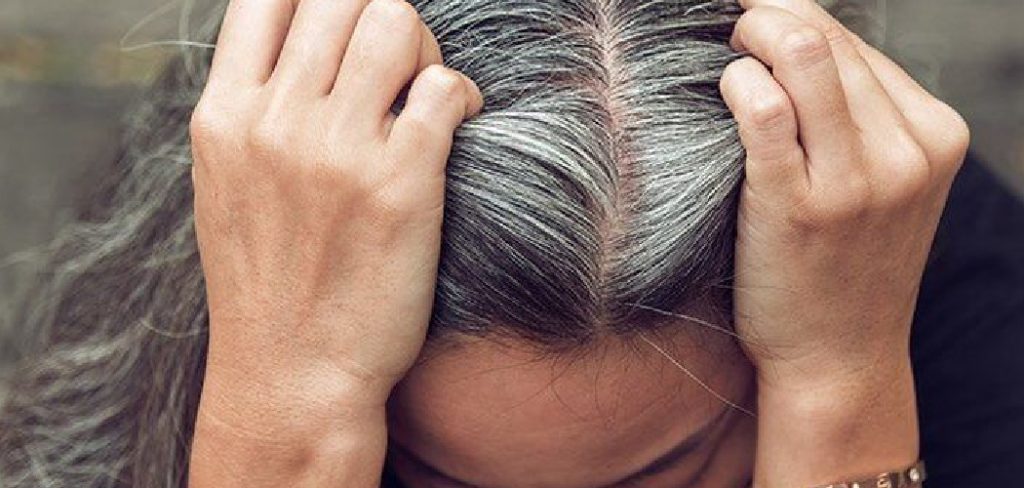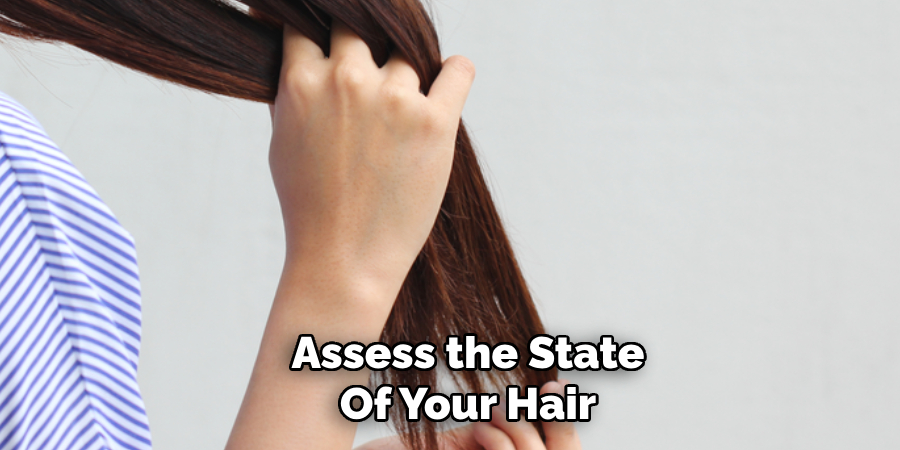Is your hair healthy? Having healthy hair is not only beautiful but also gives you confidence in your appearance.
Having healthy hair is often a reflection of overall well-being and effective hair care practices. Whether your hair is curly, straight, thick, or fine, specific universal indicators can help determine its health status.

Understanding these signs not only aids in maintaining the luster and integrity of your hair but also assists in identifying areas that might require more attention.
In this guide on how to tell if you have healthy hair, we’ll explore what characteristics denote healthy hair and provide insights into keeping your locks in optimal condition. From texture and shine to elasticity and moisture, we’ll cover the essential aspects that contribute to the vitality of your hair.
What Will You Need?
Before we dive into identifying healthy hair, it’s essential to have a basic understanding of your hair type and its individual needs. Different hair types require distinct care routines to keep them healthy. Here are some items that can help you assess and maintain the condition of your hair:
- A Mirror: This will allow you to examine your hair closely and examine its texture, shine, and overall appearance.
- Hairbrush or Comb: These tools can help you detangle and style your hair without causing damage.
- Natural Light: Natural lighting is best for examining your hair as it provides accurate color representation.
- Hair Products: Depending on your hair type, you’ll need specific products suited for its needs. This could include a shampoo, conditioner, and additional treatments or styling products.
- A Healthy Diet: Your diet plays a significant role in maintaining healthy hair. Ensure you consume essential vitamins and nutrients to promote strong and shiny locks.
Once you have these items, you’re ready to assess the state of your hair and determine whether it’s healthy or needs extra care.

10 Easy Steps on How to Tell if You Have Healthy Hair
Step 1: Check for Shine
Shine is one of the most noticeable indicators of healthy hair. It signifies that the hair cuticles are lying flat and reflecting light, giving your locks a glossy appearance.
To check for shine, examine your hair in natural light, as it provides the most accurate representation of your hair’s sheen. If your hair looks dull or lackluster, it might indicate damage or dryness. Regularly using nourishing hair oils or serums can help enhance shine by sealing the hair cuticles and retaining moisture.
Additionally, ensure you’re not over-washing your hair, as this can strip away its natural oils, leading to a dull appearance. If your hair is naturally very curly or textured, you might notice less shine than straight hair, as curly strands reflect light differently. Nonetheless, achieving a healthy glow is possible for all hair types with the proper care and products.
Step 2: Evaluate the Texture
Texture plays a crucial role in determining the health of your hair. Healthy hair often feels smooth and robust to the touch, regardless of whether it’s okay, medium, or coarse. Run your fingers through your clean, dry hair to assess its texture. It should feel soft and free of excessive tangles or knotting. If your hair feels brittle, rough, or frizzy, it might be experiencing damage or lacking essential moisture.
Incorporating a deep conditioning treatment into your routine can help restore softness by infusing your hair with much-needed nutrients. Additionally, reducing the use of heat-styling tools and protecting your hair from environmental stressors such as sun exposure and pollution can help maintain its natural texture and prevent damage.
Step 3: Assess the Elasticity
Elasticity is a crucial indicator of healthy hair, reflecting its ability to stretch and return to its original length without breaking. To test your hair’s elasticity, take a small strand of wet hair and gently pull it. Healthy hair will stretch up to 50% of its original length and bounce back. If your hair breaks easily or doesn’t return to its average size, it might be a sign of damage or protein deficiency.
Incorporating protein treatments and maintaining a balanced diet rich in vitamins and minerals can help improve elasticity. Additionally, avoid over-processing your hair with chemical treatments and excessive heat styling, as these can weaken hair fibers and reduce elasticity. Regularly trimming your hair can also help keep it resilient by removing split ends and minimizing breakage.

Step 4: Observe the Scalp Condition
The condition of your scalp can significantly impact the overall health of your hair. A healthy scalp should be free from itchiness, redness, or flakiness. Run your fingers gently over your scalp and observe its texture and appearance. If you notice excessive oiliness, dryness, or dandruff, it might indicate an imbalance that could affect your hair’s health.
To maintain a balanced scalp environment, incorporate gentle cleansing products that do not strip natural oils, and use treatments such as moisturizing masks or scalp exfoliants to address specific issues. Ensuring your scalp is healthy through proper hygiene and care can promote optimal hair growth and prevent common hair concerns. Avoid tight hairstyles that could tug on your scalp, and consider consulting with a dermatologist if scalp issues persist.
Step 5: Test for Moisture Content
Moisture is essential for maintaining the hydration and suppleness of your hair. To evaluate your hair’s moisture levels, spritz a small section of dry hair lightly with water. Healthy hair should absorb moisture easily without feeling overly saturated or dry.
If your hair repels water or feels exceptionally brittle, it might indicate dehydration. Incorporating hydrating shampoos, conditioners, and deep conditioning treatments into your routine can help replenish moisture and restore balance. Additionally, limit washing your hair to prevent stripping its natural oils, and consider using a leave-in conditioner or hair mask to lock in moisture.
Step 6: Monitor the Level of Hair Loss
Hair loss is a natural part of the hair growth cycle, but excessive shedding can indicate underlying issues. To assess your hair loss level, pay attention to the amount of hair you lose daily, keeping in mind that shedding 50 to 100 strands daily is considered normal.
If you notice more significant hair loss, it could be due to stress, nutritional deficiencies, hormonal changes, or scalp conditions. To manage excessive hair loss, ensure that your diet includes essential vitamins and minerals, such as biotin, zinc, and iron, vital for healthy hair growth.

Step 7: Consider Your Hair’s Porosity
Hair porosity refers to your hair’s ability to absorb and retain moisture, impacting how it responds to various hair products and treatments. To test porosity, place a clean strand of dry hair in a glass of water. Observe how the strand behaves: if it floats, your hair has low porosity, indicating that its cuticles are tightly closed and struggle to absorb moisture.
If it sinks quickly, your hair is highly porous, meaning the cuticles are more open and can absorb moisture quickly but may have trouble retaining it. Balanced porosity typically means the strand neither sinks rapidly nor floats stubbornly. Understanding your hair’s porosity can help you choose the right products and treatments to maintain moisture balance and ensure your hair remains healthy and manageable.
Step 8: Evaluate the Shine and Luster
Shine and luster are indicators of hair health and vitality, reflecting how well the hair’s cuticle lies flat to reflect light. To assess this aspect, examine your hair in natural light. Healthy hair will exhibit a natural sheen and appear lustrous, while dull or lackluster hair may indicate underlying issues such as dryness, damage, or nutrient deficiencies.
Consider using hair oils or serums that add gloss and smooth the cuticles to enhance shine. Ensure your diet is rich in omega-3 fatty acids and antioxidants, which can nourish hair and contribute to its natural glow.
Step 9: Assess the Strength and Breakage Level
Strength and resistance to breakage are critical indicators of healthy hair. To evaluate your hair’s strength, gently stretch a wet strand; healthy hair will exhibit some elasticity without snapping. If you experience frequent breakage, it could signal weakened hair fibers.
Chemical processing, poor nutrition, and excessive styling can compromise hair strength. To enhance hair resilience, incorporate protein-rich treatments that help reinforce the hair shaft and reduce breakage.
Step 10: Identify Any Underlying Scalp
Recognizing and addressing any underlying scalp or hair conditions is crucial for optimal hair health. Common issues such as dandruff, psoriasis, or dermatitis can affect your scalp and hair’s condition, leading to inflammation, itchiness, or excessive flaking.
To identify potential problems, closely examine your scalp for any signs of irritation or abnormal changes. Pay attention to symptoms such as persistent itchiness, redness, or swelling, which may indicate an underlying condition. Consulting with a dermatologist or trichologist can provide a more accurate diagnosis and effective treatment options.
Following these ten steps, you can accurately assess your hair’s health and make informed decisions to maintain vitality and manage any underlying issues effectively.

Conclusion
In conclusion, how to tell if you have healthy hair requires a comprehensive understanding of various factors, including moisture levels, hair loss, porosity, shine, strength, and underlying scalp conditions.
By carefully assessing each of these aspects through simple tests and observations, you can accurately determine the overall health of your hair.
Adopting a balanced hair care routine tailored to your specific hair needs and incorporating nourishing hair products, a diet rich in essential nutrients, and lifestyle adjustments that minimize damage is necessary. Regular monitoring and proactive management of any issues will help ensure your hair remains vibrant, resilient, and full of life.
Understanding your hair will empower you to make informed decisions and enjoy the confidence of having healthy, beautiful hair.
About the Author
Jane Hubbard is a passionate beauty expert with a wealth of experience in makeup, hair, and overall beauty techniques. After years of working as a hairdresser specialist, she followed her entrepreneurial spirit and started her own consultancy business.
Jane has always been driven by her desire to help others feel confident in their own skin, and she does this by sharing her knowledge, experiences, and practical beauty tips. Through her consultancy, she empowers individuals to embrace their unique beauty, offering tailored guidance that boosts both self-esteem and personal style.
Professional Focus
- Specializes in makeup, hairstyling, and beauty consulting.
- Provides personalized beauty advice, tips, and techniques to help individuals feel confident in their appearance.
- Dedicated to staying up-to-date with the latest industry trends and developments.
- Passionate about creating a comfortable and empowering experience for every client.
Education History
- University of Craft and Design – Bachelor of Fine Arts (BFA) in Woodworking and Furniture Design
- Woodworking Apprenticeships – Extensive hands-on training with skilled craftsmen to refine carpentry and furniture making techniques
- Online Courses & Masterclasses – Continued education in advanced woodworking techniques, design principles, and specialized tools
Expertise:
- Makeup artistry, hairstyling, and beauty consulting.
- Personalized beauty techniques to enhance confidence and self-expression.
- Educating clients on how to maintain their beauty routines at home.
